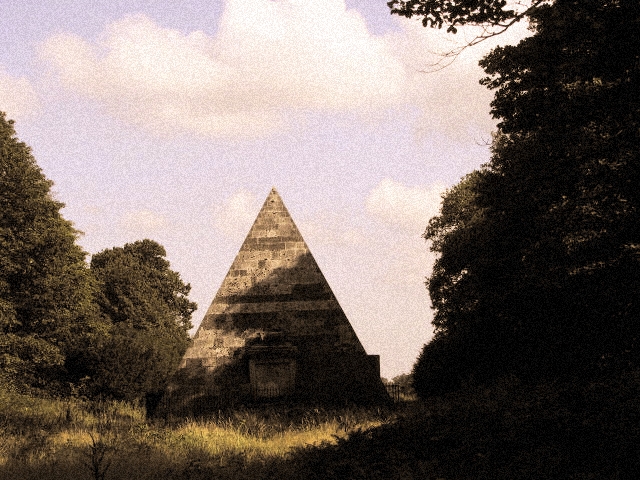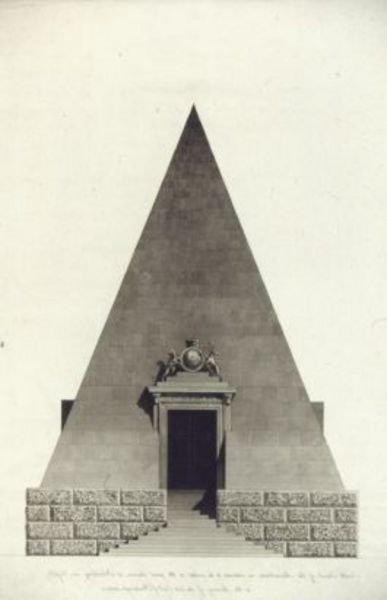I headed there in an act of investigation, off the back of a recommendation from an old acquaintance, one Mr Francis Kaye. Hadn’t heard from Kaye in around three years, we weren’t ever that close when we were younger, not in any traditional sense, passing by year in year out, crossed documents, information shared, both attempting to find a pattern within existence.
Arrived around midday, there was – even at this time of day – a cool layer of air about the forest. Lightly trodden paths amongst thick bracken, roots spiralling out atop the dry ground, this was most certainly the place of Kaye’s note.
It would be callous of me to put my findings down to the mere ‘cult of Egyptology’.
After walking for some time I reached an opening in the woodland. Before me an arch of trees looking out onto a plane of grass and unto the other side a return to the woodland. Yet as one breaches the treeline they’ll find their peripheral vision clouded by a tall grey intrusion. To pan to the right one finds a pyramid within the heart of the country. Perhaps 40ft high and made entirely of stone, the structure stands in complete isolation from nature, a memoir of its own creation, as if appearing from a minor crack in time.

The Mausoleum of the Lemurs
It was in fact the very thought of the pyramid’s place in time that made my investigation so thorough. Kaye would often recommend me places of note, ritual sites, burial mounds etc. And these would more often than not add only a footnote to a tiresome linear history. I’m sick of the past to be quite honest, all these flippant thousand page documents containing detail after detail of dead time, I cannot be bothered no more to jot down the dead lives of a dead time.
With this in mind one might be surprised that I even continued my investigations. The history of the pyramid – classically speaking that is – is quite straightforward, as I had gathered from my research prior. It is a mausoleum, built in 1794 and containing the remains of the 2nd Earl of Buckinghamshire John Hobart and his first and second wives, Mary Anne and Caroline. Within the – very lacking – written history of the mausoleum there is little of note, even cross-referenced researched would amount to the single following passage:
“One of the most severe yet dramatic of all such monuments, Bonomi’s mausoleum takes the form of a stone pyramid based on the tomb of Caius Cestius in Rome, its height and breadth being of equal length. Inside there is a central domed space with eight radiating barrel-vaulted alcoves. The three alcoves facing the entrance contain the marble sarcophagi of the Earl and his two wives. The burial chambers are thought to be concealed within the walls. The floor is paved with marble slabs.” – MMTrust
Let it be known however, upon walking closer to the pyramid my stomach bound to a knot. The lining of trees and overgrown grass seemed to pause sporadically. The pyramid loomed high and the open plane became a channel for the cold wind.
I returned home swiftly and began undertaking further research at once.
I already knew the mausoleum itself was built in 1794. However, I was yet to research into the architect. Who would design – and concededly place – such a geo-temporal anomaly? That is, dear reader, why did that pyramid feel not just out of place, but out of time.
The pyramid was designed by one Joseph Bonomi the Elder:
The style adopted by him was the Italian or modernised Roman; and he sought to obtain the characteristic effect appropriate to the object of his design, rather by just proportions and good details than by unnecessary ornamentation and littleness of parts, thus exhibiting his preference for the “Architecturesque” over the “Picturesque.” – Papers Read at the Royal Institute of British Architects

Original Design
Bonomi’s mausoleum is architecture of detailed rebellion against the nature of greenery and temporality, the pyramid-shape itself splitting – vortexing – upwards into the sky.
And yet it is of Bonomi’s son, Joseph Bonomi the Younger unto which my research really took its strides. For Bonomi the Younger himself became a prominent sculptor and Egyptologist, with an insatiable interest in the afterlife, a fact which is present both in his own writings and designs. One of Bonomi the Younger’s designs has retained a cult-like status amongst those interested in time, space and immortality.
The Courtoy Tomb is – alike the pyramid – of Egyptian styling, has no record of construction and seemingly a keyhole without a key. The tomb itself is rumoured to be a time machine. Whether or not this is a metaphor dragged from the fact it has potential for underground linkage and thus a ‘saving of time’ is up for debate. What isn’t up for debate is the fact the tomb itself is covered into Egyptian iconography:

“Its occupants are a mysterious trio of spinsters about whom almost nothing is known. Intrigued by the tomb, writer Howard Webster began researching its origins and now believes the 20-foot tall building was a time machine built by a maverick Victorian genius, Samuel Warner, who also invented the torpedo. Warner is buried in an unmarked grave about 70 feet from his creation and in another nearby grave lies his likely collaborator, architect and Egyptologist Joseph Bonomi.”
What adds to the mystery is that some people believe Warner, who was in negotiations over his plans for aerial bombs and sea mines with Duke of Wellington, commander in chief of Britain’s army, was either murdered to prevent his designs for weapons falling into the wrong hands, or by someone who stole them from his dead body. However, others believe Warner was either a crackpot or a fraud whose inventions could never have worked.
Warner’s colleague Bonomi was in the team of Egyptologists and archaeologists who first deciphered the hieroglyphic texts found on papyri in Egypt’s Valley of the Kings.
James Mackay, a spokesman at Brompton cemetery, reportedly said at the time of the Reuters story: “It could be that some of the papyri they were decoding dealt with time travel.” – Badwitch
Both a father and son having a dedicated interest in Egyptology is not uncommon for the educated of Victorian England, yet the strange placements, the odd rumours, the lack of record and accessibility, the very fact my blood slowed to a crawl upon approach all speak to me of a connection unto which one should not venture, and yet I feel myself pulled towards their cold temporal nature more and more.
Further research expanded upon the feeling of dread surrounding:
“Sixty feet away, Bonomi’s gravestone bears similar hieroglyphic carvings including the Egyptian god of the dead, Anubis, sitting on what appears to be a replica of the mausoleum. Webster believes this is a vital clue to the mausoleum’s secret. The direction Anubis is facing – toward the mausoleum – suggests in Egyptian mythology a soul lost out of time.” – Badwitch
“I like to believe that Warner’s is not the body in the unmarked grave but that he is still alive and travelling through time in his machine.”- Badwitch
I slept and dreamt of time.
When I woke I planned to venture back to the pyramid, assess the area, and tread into the cosmic ripples. During my journey there I thought of William Burrough’s lemurs from the Ghost of Chance. The fragmented conception of time that Burrough’s chose to address within his novella resonated with me. “There is always something a man must do in time.” (p5) Burroughs notes. The entire novella weighted-down by the very fact that time “is not a human invention, but a prison.”(p16). The Bonomi’s struck me as a lineage attempting to free themselves from time, ‘How?’ of course was the question, not the ‘Why?’ for there are many clear answers why a man would wish to free himself from time, the ‘How?’ is of importance.
Upon my second walk to the mausoleum I began thinking of the Cybernetic Culture Research Unit (CCRU) and their piece Lemurian Time War. A piece in which they extrapolate on the premise that Burrough’s Ghost of Chance is in fact a hyperstitional document of the utmost importance in an occult time war. ‘Hyperstition’ – in short – meaning ‘fictions that make themselves real’. Usually by the propagation of signs and writing and then utilization of both as a function within reality. I began to think of the lengths the Bonomi’s had gone to effect the temporal flow of the ‘present’ reality. Their architecture functioning as inter-temporal signs intended for the making of a transition. That is both mausoleums – the pyramid and the tomb – stand alone as remnants of distant culture and time.
A citation from Lemurian Time War resonated with the temporal totality I’d found myself within, as if reaching from the pages a lemur-tale teased a communication, ‘And what is a virus? Perhaps simply a pictorial series like Egyptian glyphs that make itself real’ (Ah Pook is Here p102). I thought of this quote as I ventured into the opening once more, a distinct cosmic paranoia allowed me black-tunnel vision of the pyramid alone. The tree-linings disintegrated into a haze and the grass a blur. The mausoleum’s edges stark against the dead sky and its stone fluctuating between stages of corrosion and decay.
I proposed to myself that the Bonomian time-machine was not of any ‘traditional’ mechanics. Those who merely dismiss the rumour as just that, ‘a rumour’, are missing the point entirely. The Bonomian time-machine is a hyperstitional time-machine. Their intricately composed ‘fiction’ is assembled both throughout time and of pieces of time. Both mausoleum’s have a semiotic connection to the Egyptian afterlife and are created in such areas as to cause temporal and aesthetic confusion and resonances, hyperstitional-juxtaposition; the uncanny manner of the old man’s etiquette transports you to another social bearing. And finally they lay the pure-framework of Hyperstition via the virile subtly of rumours, for who cannot resist the allure of a time machine. And as the rumours expand, grow and infect their hosts, and as the tombs root into a time not of their own, and as the semiotic cybernetic family lineage interconnects throughout and during time the fiction comes ever closer to a reality, the Bonomian time-machine reverse engineer’s its own becoming by tricking the fictions of others into assimilating it.
I stood before the percolating mausoleum a man allowed but a glimpse of a cyber-temporal whole. Burroughs along with the CCRU note that “The Word Lines keep you in time…” (Word Virus, p270). That is, in accordance with the occult time war, the One God Universe (OGU) which can be thought of as complete-centrality, Order, Oneness, Control, created a fiction so oppressive that it gave birth to the reality of “biological destiny and immortality” (CCRU, p37). For there to be control, there has to be time, a system of time, or in more practical terms there has to be a time of succession. And as such once the written fiction of the OGU commenced it assimilated each and every other fiction into its own time-system.
My mind digressed at a frantic rate, pacing back and forth between excerpts of Kant, Nietzsche, Burroughs and the CCRU, piecing together the sporadic remains and becomings of a fiction I wasn’t supposed to witness. Inscribed above the mausoleum’s door are the words “AVCTOR PRETIOSA FACET” translated as “the giver makes the gift precious”. The gift here being the first node in the Bonomian temporal-network, ‘given’ knowledge of paths through succession, hyperstitional landmarks juxtaposed in time to emit a previous or coming reality. A pathway through time bouncing lost souls to and fro.
The area vibrated minutely. My vision became akin to a fish eye lens, bearing down into the doorway. My peripheral vision was of frantic black splodges, darting reds and whites, as if a retro-virus had begun to wipe my perspective frame by frame, and complete corneal meltdown. And suddenly nothing, then release. As if awaking from a slow sleep paralysis that which I now saw could have been dream, could have been reality, but what I truly feared was a mixture of the two.
I pulled my gaze down from the doorway, away from the pithy inscription. I took a few steps backwards from the doorway looking around and the lagging grass. Between the tall blades and thick clumps – I believe – appeared curled black tails, red dots and tufts of dark smoke. Fading in and out of the meadow indiscriminately were the silhouettes of lemurs. The spots of temporary darkness spread to the back of the meadow and all the way to the tree line, a viral quasi-spacio-temporal rift pulsating into a drawn out single moment fell over the mausoleum, and then, the winds swept and the birds tweeted. What was this but a warning in time?
I began the journey home.
Read More
